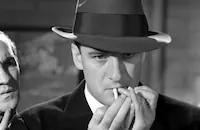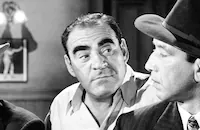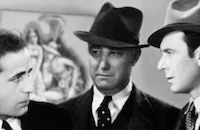Waterfront

Brief Synopsis
Cast & Crew
Terry Morse
Gloria Dickson
Dennis Morgan
Marie Wilson
Sheila Bromley
Larry Williams
Film Details
Technical Specs

Synopsis
Longshoreman Jim Dolen, the hot-tempered president of the Waterfront Club in New York City, an association of dockworkers, gets into a fight with Mart Hendler, his opponent in the election for president, when Hendler refuses to comply with an order. When Jim's friend, Frankie Donahue, tries to stop the fight, Jim slugs him, and Frankie's head hits an anchor as he falls. Jim is jailed for assault and is relieved to learn while in jail that Frankie has revived and soon will be sent home. Jim's fiancée, Ann Stacey, who is deeply worried about his propensity for fighting, speaks with the new parish priest, Father Dunn, who then visits Jim in jail. When Jim explains that his father taught him never to let others make a "sap" of him, Father Dunn calls him a coward and says that he is afraid that if he does not take advantage of others, they will take advantage of him. Father Dunn's rebukes have an effect on Jim, and when he gets out of jail, he promises Ann to try to understand what Father Dunn told him. Jim and Ann get married and plan to move to a ranch. At the Annual Longshoremen and Stevedore's Ball, Jim graciously suggests that Hendler be made the new president. After a very drunk Hendler insults Jim during his acceptance speech, Jim tells the gathering that Hendler will make a good president even though he is drunk. At the laughter this remark provokes, Hendler throws a bottle at Jim, and Jim's brother Dan pushes him out of the way. Dan is killed by the bottle, and Hendler's girl friend, Marie Cordell, gets him away before the police arrive. Jim threatens to kill Hendler if the police fail to arrest him in twenty-four hours. After Dan's funeral, Father Dunn learns that Jim has gone after Hendler with a gun and tells the police, and an all-cars bulletin is put out for Jim. When he sees a police car, Jim surreptitiously gives his gun to Frankie, who has forgiven him for the earlier incident. Jim is picked up, but the captain of detectives cannot hold him because he has broken no law. Meanwhile, Hendler, terrified to give himself up and face the punishment of death for something he didn't mean to do, implores Marie to get enough money for them to leave the country. When the police break into Marie's apartment, Hendler escapes through a window. Because none of Hendler's "friends" will give Marie money to pay the skipper of a boat on which they plan to escape the country that night, Marie gets Ann to give her the money by convincing her that Hendler is no more a killer than Jim would have been if Frankie had died, and that if Hendler does not escape, Jim will either kill him outright or in a courtroom. Jim's friend, Skids Riley, overhears their conversation and tells Jim, who angrily confronts Ann. Just then, Frankie tells Jim that he has learned that Hendler is hiding above the Mariner's Restaurant. To stop Jim, Ann pulls a gun on him, but he slugs her and takes it away. Ann gets the police, who then arrest Jim for carrying a concealed weapon. However, with Frankie's help, Jim escapes from his cell. When Ann hears about the escape on the radio, she goes to the Mariner's Restaurant. Thinking that she is double-crossing him, Hendler slugs Ann and puts her in a closet. When Jim arrives, Hendler hides outside the window. Marie tells Jim that Hendler has left, but when Jim hears Ann fall over in the closet, he thinks it must be Hendler and raises his gun to shoot. Marie stops him, and Jim and Ann embrace, while the wire supporting Hendler on the ledge gives way, and he falls to his death. Marie cries over his body. Father Dunn convinces the judge to commute Jim's sentence to probation and then blesses him and Ann as they leave for their ranch.

Director
Terry Morse
Cast

Gloria Dickson

Dennis Morgan

Marie Wilson
Sheila Bromley

Larry Williams
Aldrich Bowker
Frank Faylen

Ward Bond
Arthur Gardner
George Lloyd
Dutch Hendrian

Lee Phelps
Jerry Fletcher
Eddie Marr
Charles Sullivan

Elliott Sullivan
Joe Devlin
Max Wagner
Paul Bryar
Alice Connor
Jack Goodrich
Sally Sage

John Ridgely
Eddy Chandler
Tommy Bupp

John Hamilton

Ralph Dunn
Cliff Saum
William Gould
Sam Bernard
Al Downing

Jack Mower
Charles Delaney
Frank Mayo
Hal Craig
Philip Morris
Charles Trowbridge
Al Lloyd
Crew
Milo Anderson
Bryan Foy
Les Guthrie
Louis Hesse
Stanley Jones
Lee Katz
Fred Niblo Jr.
Charles Novi
Arthur Ripley
Arthur Ripley
Don Ryan
James Van Trees
Jack L. Warner

Photo Collections
Videos
Movie Clip


Trailer
Film Details
Technical Specs

Articles
Waterfront - Waterfront
Those opening moments don't last long as Waterfront (1939) speeds along to its conclusion a mere 59 minutes away. And in that 59 minutes Waterfront packs in more plot, more story, and more drama than most full two hour length productions. It's exactly the kind of fast-paced, low budget crime movie that Warner Brothers specialized in during the thirties.
The movie opens as Ann Stacey (Gloria Dickson) posts a memo on the pier bulletin board explaining all items have to be off the pier by a certain hour by order of the Waterfront Association's president, Jimmy Dolan (Dennis Morgan). The memo serves two dramatic purposes: it lets the viewer know who Jimmy is and sets up a fight between Jimmy and Mart Hendler (Ward Bond) when Mart won't listen. The fight leads to Jimmy accidentally pushing his friend, Frankie Donahue (Larry Williams), head first into an anchor, resulting in Jimmy's arrest which, in turn, leads to a jailhouse redemption of spirit. Well, sort of.
Jimmy's visited by Father Dunn (Aldrich Bowker) who gives Jimmy the kind of honest talking to that Jimmy hasn't heard but needs to. Jimmy decides to give up violence, turn over a new leaf, and even recommend Mart as the new president once he, Jimmy, resigns as president of the association. That doesn't turn out to be a very good idea and Jimmy's vow to never fight again is quickly, and tragically, pushed aside. Events occur that pit Jimmy against Mart and neither one intends to let the other walk away from it breathing.
Dennis Morgan was a rising star at Warner Brothers and had just recently dropped his previous stage name, Richard Stanley (for the record, his birth name was Earl Stanley Morner), making Waterfront the first movie to credit him as "Dennis Morgan." He never became the big star Warners wanted but he did manage a couple of big hits with Kitty Foyle (1940), the movie that won Ginger Rogers an Oscar, and Christmas in Connecticut (1945). He does a fine job here and had the movie been given a bigger budget and marketed widely, might have made Morgan the star the studio wanted. Of course, there's no guarantee of that. Tough guy roles work magic for some but not for others. James Cagney became one of the all time biggest stars in Hollywood playing tough guys while another excellent performer like George Raft never got past the second tier. Perhaps Morgan never would have either but it would have been nice to see for sure had this film played wider.
Ward Bond impresses, once again. As the hot-tempered, bullying Mart, Bond is excellent, playing the role to perfection. For someone who appeared in as many films as Bond, it would be understandable if audiences grew tired of him but Bond never gave them a chance. The man never phoned in a single line, not a single moment, in his entire career. He remains one of the greatest character actors the golden era of Hollywood ever knew.
The real star of the movie, and its tragic center, is Gloria Dickson, who not only does a great job but carries many of the more dramatic scenes on her shoulders. Dickson was a young actress, working in B movies and hoping to strike the big time. She had a strong, steady voice, a beautiful face, and a real acting talent. Her career would go no further than 1945, however, when her life came to its sad demise. At the age of 27, Dickson found herself trapped behind a wall of fire in her Los Angeles home. She and her dog were found in the bathroom, apparently trying to escape the fire (burns indicate she tried getting through the flames before succumbing to smoke inhalation). It was a career cut short, one that may have flourished for years to come.
Waterfront is a great example of the fast-paced, plot-packed, B-movie dramas that Warner Brothers did so well. It stars an actor who never became as big as he should have, a character actor who acted in some of the greatest movies of all time, and a young starlet who never got to see the long career she deserved. For all those reasons and more, it's well worth a look.
Producers: Bryan Foy, Hal B. Wallis, Jack Warner
Director: Terry O. Morse
Screenplay: Lee Katz, Arthur Ripley, Kenyon Nicholson (based on his play Blind Spot)
Music: Heinz Roemheld
Cinematography: James Van Trees
Editing: Louis Hesse
Art Direction: Charles Novi
Costume Design: Milo Anderson
Cast: Gloria Dickson (Ann Stacey), Dennis Morgan (James 'Jim' Dolan), Marie Wilson (Ruby Waters), Sheila Bromley (Marie Cordell), Larry Williams (Frankie Donahue), Aldrich Bowker (Father Dunn), Frank Faylen (Skids Riley), Ward Bond (Mart Hendler), Arthur Gardner (Dan Dolan), George Lloyd (Joe Becker)
By Greg Ferrara

Waterfront - Waterfront
Quotes
Trivia
Notes
According to a news item in Hollywood Reporter, this picture was filmed on location in San Pedro, CA. This was the first time that the actor previously known as Stanley Morner and Richard Stanley used the name Dennis Morgan.















